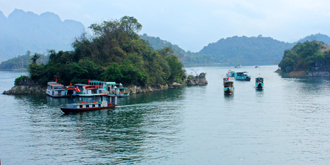
(HBO) – Ngoi Hoa Bay, where green stony islands float on the clear greenish blue water under the sunny sky, is a popular tourist destination in Ngoi Hoa commune, Tan Lac district, Hoa Binh.
The commune is also blessed with Hoa Tien Cavern, which is sure to amaze
visitors with countless glistening stalactites and stalagmites in thousands
different forms.
About 1km to the east of Hoa Tien Cavern is a
large crystal-blue water lake which is called by the locals "Tien Tam Lake”,
meaning the lake where fairies bathe. After work, many young girls often go
down there together for a bathe, and you can hear them giggling while getting
relaxed in the water just like the fairies in fairy tales.
To get to the cavern, you will have to cruise
through Hoa Binh Lake where you can enjoy a magnificent view of surrounding
mountains and forests. You can also visit Thac Bo Cavern and Bung Cave, known
as local archaeological relics.
Ngoi Hoa commune is home to about 80 families of
Muong ethnic minority group whose ancestors struggled to make ends meet hundred
years ago by picking, hunting and farming on mountainsides year round.
Today, the people make their living out of
aquaculture, forestry and tourism that provide them better living standards.
They make use of the land surrounding the bay to grow acacia and bamboo trees,
alongside melons, papaya, bananas, gourds and orchids. There are about 300
species of orchids in the Hoa Binh Lake and Ngoi Hoa Bay areas. Local people
have also built dozens of stilt houses to serve visitors.
Visitors here are always well treated with
traditional foods and drinks, which are so tasty and special, like "com lam”
(rice cooked in bamboo tubes), "xoi do trung kien” (sticky rice with ant eggs),
"nhong ong” (bee larvae), "trau nau la lom” (buffalo meat cooked with "lom”
leaves), "ca nuong nau mang chua” (grilled fish with bamboo shoots) and more.
In addition, the visitors can enjoy local folk
cultural performances, including playing of special traditional instruments and
dances.
Spanning thousands of hectares and winding gracefully along mountain slopes, hillsides, and riverbanks, the terraced rice fields of Lac Son District present a stunning and captivating beauty. This region, renowned for its remarkable terraced landscapes, is also the centre of Hoa Binh Culture known for numerous archaeological sites.
The life of Mong people in Hang Kia and Pa Co communes of Mai Chau district has improved much thanks to tourism development.
The man-made Hoa Binh Lake, with a water surface area of approximately 9,000 hectares and a capacity of 9.45 billion cubic meters, stretches over 200 kilometers from Hoa Binh to Son La provinces. With the goal of developing into a national tourism area, the Hoa Binh Lake tourism area is expected to not only become the largest tourism centre in the province but also one of the 12 key tourist destinations in the northern midland and mountainous region of Vietnam.
Da Bia hamlet, now Duc Phong, in Tien Phong commune, Da Bac district, was once almost isolated from the outside as the only way to the hamlet was to get a boat ride across the Hoa Binh reservoir. However, as its tourism potential has been unleashed, the hamlet has established itself as one of the most attractive destinations on the tourism map. It has even received the ASEAN Community-Based Tourism Awards in 2019.
In the first 9 months of 2024, Mai Chau district, Hoa Binh province welcomed over 684 thousand visitors to visit and relax. In which, over 516 thousand domestic visitors and more than 168 thousand international visitors. Total revenue from tourism is estimated at over 821 billion VND.
Da Bac district, bestowed with stunning landscapes, is developing ecological and resort tourism offerings. Several tourist sites, put into operation this year, has attracted throngs of high-spending and young domestic visitors.


